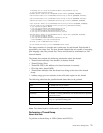The HP HotSpot JVM is used when you deploy Sterling B2B Integrator on a
HP-UX for IA64 (Itanium) or HP-UX on any other processor.
HotSpot JVMs provide many tuning parameters. There is no golden set of JVM
settings that apply to all customers and conditions. Fortunately, the HotSpot JVMs
provide good measurement feedback that allows you to measure the effectiveness
of the settings. The settings, especially memory settings, are highly dependent on:
v Transaction mix
v Amount of data cached
v Complexity of the transactions
v Concurrency levels
This topic describes the processes involved in planning, implementing, configuring,
monitoring, and tuning the HotSpot Java Virtual Machines.
To enable JVM verbose garbage collection, refer to the documentation on JVM
parameters for the server in “Edit Performance Configuration Settings” on page
123.
To enable JVM verbose garbage collection for the container JVM, refer to the
documentation on JVM parameters for container nodes in “Edit Performance
Configuration Settings” on page 123.
For information on the default parameters for the HotSpot JVM, refer to “HotSpot
JVM Default Parameters” on page 66.
HotSpot JVM Heap Memory and Garbage Collection
The JVM run-time environment uses a large memory pool called the heap, for
object allocation. The JVM automatically invokes garbage collections (GC) to clean
up the heap of unreferenced or dead objects. In contrast, memory management in
legacy programming languages such as C++ is left to the programmer. If the JVM
heap settings are not set correctly, the garbage collection overheads can make the
system appear unresponsive. In the worst case, your transactions or the JVM may
abort due to outOfMemory exceptions.
Garbage collection techniques are constantly being improved. For example, the Sun
JVM supports a "stop-the-world" garbage collector where all the transactions have
to pause at a safe point for the entire duration of the garbage collection. The Sun
JVM also supports a parallel concurrent collector, where transactions can continue
to run during most of the collection.
The Sun heap and HP heap are organized into generations to improve the
efficiency of their garbage collection, and reduce the frequency and duration of
user-perceivable garbage collection pauses. The premise behind generational
collection is that memory is managed in generations or in pools with different
ages. The following diagram illustrates the layout of the generational heap.
64 Sterling B2B Integrator: Performance Management


















